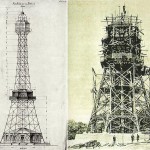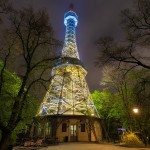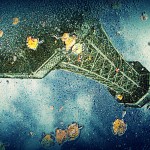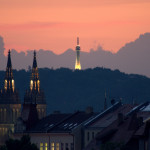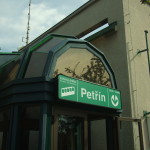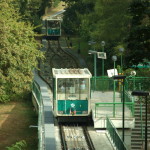Five times smaller than the Eiffel in Paris, the Petřín Tower was built in just four months. Even if today it is purely a scenic attraction, the tower was used as a radio and television station in the past
With an exotic touch and an unquestionable visual impact, the miniature reproduction of the Eiffel Tower stands imposingly on top of the Petřín hill. The most imitated monument in the world boasts replicas from Tokyo to Las Vegas, from China to Russia, but the Prague tower was actually one of the first.
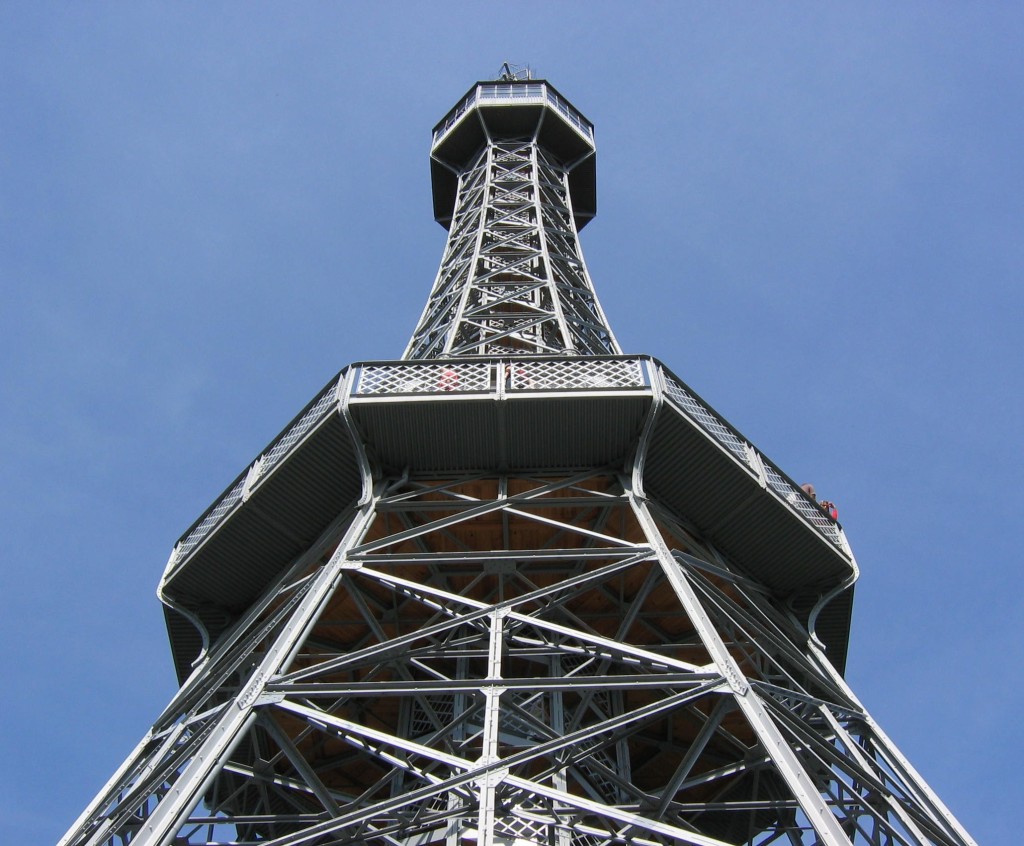 In 1889 Vilém Kurz and Vratislav Pasovský, founders of the Czech Tourist Club, went to visit the World’s Universal Exhibition in Paris to discover the great architectural work of Eiffel, and on their trip home, they resolved to try and recreate the same dazzling atmosphere even in Prague – with an imitation tower that would dominate the city. If in ancient times they used to keep their enemies and herds under surveillance from their high towers, at the end of the nineteenth century, the Romantics began to discover the charm and beauty of the landscape. The Petřín hill, the highest peak in the capital at 318 meters above sea level, was the ideal site; an open viewpoint over a large part of the Czech kingdom. Their dream was set.
In 1889 Vilém Kurz and Vratislav Pasovský, founders of the Czech Tourist Club, went to visit the World’s Universal Exhibition in Paris to discover the great architectural work of Eiffel, and on their trip home, they resolved to try and recreate the same dazzling atmosphere even in Prague – with an imitation tower that would dominate the city. If in ancient times they used to keep their enemies and herds under surveillance from their high towers, at the end of the nineteenth century, the Romantics began to discover the charm and beauty of the landscape. The Petřín hill, the highest peak in the capital at 318 meters above sea level, was the ideal site; an open viewpoint over a large part of the Czech kingdom. Their dream was set.
By the end of that year, the Petřín observation tower Association was established and the project approved with an estimated budget of 32 thousand Fiorin. The Club anticipated the first 1,031. In 1891, the Jubilee Exhibition would soon be held in Prague and that led them to accelerate the construction of the monument. However, the search for financial resources required great effort. It was then that the editor of the club magazine, Dr. Kurz, was given the task of inspiring the public to this new idea, because most people were still unaware of the idea. On January 8, 1890 one of his articles was then published in the German newspaper Politik, which portrayed an image set in August 1891 depicting a visionary image of a modern Prague, in which the writer accompanies an imaginary guest to Újezd, where the first innovation was the funicular. It takes you up to the Nebozízek gardens, and from there, to the Prague Eiffel Tower, “whose peak was adorned with a giant crown that glittered with coloured lights”, Kurz wrote. To turn the dream into a reality, only a years’ work would be required, a rather unlikely forecast. A few sceptics, in fact, believed it was probably a joke, however, most people accepted the idea with enthusiasm and actually helped with donations.
However, it turned out to be a race against time. On 16 March 1891, work began on the basis of architect Vratislav Pasovský’s drawings, with the collaboration of engineers František Prášil and Julius Souček from the iron-works at Českomoravské strojírny. It took two months to transport the 175 tons of Kladno iron up to the top of the hill before the assembly work of the main structure. On July 2, in less than four months, the tower was finally completed and its inauguration was held on August 20. The Petřín hill was veiled with the national colours, with the red and white colours of the Bohemian flag on the peak of the structure. The dream of the Czech Tourist Club had come true.
The panoramic tower is 63.5 meters high, a fifth of the original French one, even if, because of the high ground of the hill, the height of the tips of the towers are at the same altitude. The Czechs soon renamed it “Eiffelovka”, the “little Eiffel”, and it is not simply a smaller version, but it has a number of differences. Contrary to the Parisian symbol, the tower is not supported by four steel columns, but by an octagonal brick base, from which eight arms branch out. A concept that is more reminiscent of the Götzinger Höhe observation tower, in Saxony. There is no open space on the ground floor, but an entrance hall that used to house a restaurant, and which is now a café. The basement hosts an exhibition dedicated to the Czech know-it-all Jára Cimrman, with photographs and drawings depicting the activities of the Czech Tourist Club and the various changes that were made on the Petřín hill from the period of the mines to the erection of the tower.
There are two observation platforms, one at 20 and the other at 55 meters, where visitors used to go up with a lift that was powered by a gas engine. It was later replaced with an electric one, but at the time, there was no comparison with the less modern hydraulic lift of the French giant tower. However, modernity does not prevent accidents. On July 5, 1938, during a rally of the Sokol gymnastic association, a short electrical circuit caused a fire in the cabin that, fortunately, was empty at the time. The approximate one hundred tourists on the flight of steps were evacuated in time.
Around the lift, there are two spiral staircases consisting of 299 steps each, to reach the top and come down, that do not intersect. The upper panoramic gallery offers a breathtaking view of the Castle and to the hundred towers around the capital, but on a clear day you will also be able to see the Říp and the Giants mountains. “Personally, I am always enchanted by the winter night-time view of Malá Strana”. says Jiří Čejka, the keeper. “I would go so far as to say that the famous model of Paris does not even offer a fragment of what you can actually admire over here. Which other place gives you the opportunity – from the centre of the State – to sweep your gaze from one frontier to the other?”. An understandable opposite view is that of Jean-Bernard Brose, chairman of the company that operates the Eiffel tower: “The replicas are actually an encouragement for tourists to visit the real tower. Ours has something that no other tower can have, and that is Paris”.
As for Petřín, the iron structural work does not please everyone. It actually risked being demolished. On March 15, 1939 Adolf Hitler came to Prague, in the wake of the German occupying forces. While he was admiring the scenery from the castle, he became annoyed by the tower that was ruining the landscape and wanted to have it removed.
 Today, it is only a scenic point, but in the past, it had other functions. In November 1918, an antenna was installed on it and radio station Prg Petřín became the first Czechoslovak broadcasting station. Quite soon, it established regular contacts with its neighbouring states, England and the Paris Eiffel tower station. At the time, telegraphy was a prerogative of the military and was used above all to guarantee the diplomatic correspondence between the Ministry of Foreign Affairs and its representative offices.
Today, it is only a scenic point, but in the past, it had other functions. In November 1918, an antenna was installed on it and radio station Prg Petřín became the first Czechoslovak broadcasting station. Quite soon, it established regular contacts with its neighbouring states, England and the Paris Eiffel tower station. At the time, telegraphy was a prerogative of the military and was used above all to guarantee the diplomatic correspondence between the Ministry of Foreign Affairs and its representative offices.
In 1953 it was the turn of the television transmitter. The lift gave way to the installation of cables, and visitors were allowed access only to the stairs and upper platform. Over the years, a number of records were achieved in the field of television, but in 1979, the construction was closed to the public due to its decadent state, in first place, the stairs. It was opened again only in 1991 for the centennial Jubilee Exposition, and the following year, transmissions were transferred to the new broadcasting station of Žižkov.
Today, the Petřín Tower is run by the City of Prague Museum and maintenance is carried out regularly. In March 2015 they replaced all the steps and new LED lighting was installed to enrich the variant coloured lights, that enabled it to be adorned with the colours of the French flag, after the attack of November 2015 in Paris. In 2014, it had actually ranked among the top ten Czech attractions with 557,394 visitors (70% of them foreigners, as reported by Czechtourism).
Petřín does not only pride itself for its panoramic tower. In 1891 even a funicular was opened, which for that period was a great technical achievement for its hydraulic traction and was at the same time, the oldest Czech funicular and the longest in the Austro-Hungarian Empire. The line did not include any stops and ended its run at Nebozízek after 396.5 meters and a six minutes trip. In 1932 an electric version was installed, which had its terminus at the base of the tower.
Inside a small villa that looks somewhat like a castle, there is a mirror labyrinth that provides entertainment for children and adults. When you find the exit, you come across a diorama of the battle against the Swedes, which took place on the Charles Bridge during the Thirty Years’ War, including various distorting mirrors. The labyrinth occupies the space of the pavilion of the Czech Tourist Club, which after the exhibition of 1891, was moved from the Výstaviště Fair ground to Petřín.
Whether it be spring, with the dominant pink colour of the blossoming cherry trees or autumn with its warm colours, Petřín is a place where you can walk undisturbed or stop for a picnic. In the Middle Ages it used to be covered with dense forests, that eventually gave way to the vineyards of King Charles IV, and then was transformed into a series of gardens, including the park under the tower. This is where the poetic verses of the romantic poets Karel Hynek Mácha, Jan Neruda and Jaroslav Vrchlický, used to be read and are still read – to the extent that it is now known as lovers’ hill. On the first of May, dozens of couples embrace and kiss each other under the statue of Mácha, the author of “May”.
Among the other places of interest, there is the Štefánik observatory, the Church of Saint Lawrence, which once gave its name to the hill, the monument dedicated to the victims of communism and the Wall of Hunger, with which King Charles IV gave a new fortification to the Little Quarter and employment to the population that was starving.
However, the tower with its undeniable charm, is still the main attraction and is particularly charming with the projection of lights and special effects that are put in place during the Signal festival, that shine like a beacon over the city.
by Sabrina Salomoni





